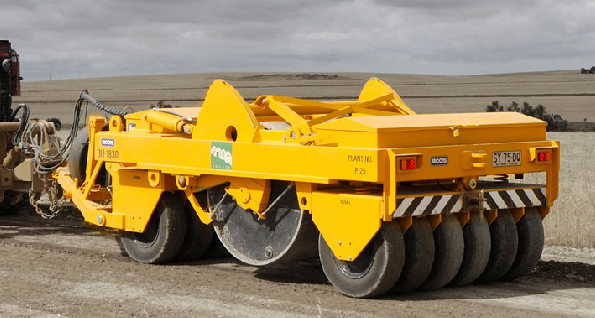Ever considered tendering for a gravel road maintenance contract with local government? They can be a consistent and reliable source of income for an owner operator. Should broader civil works soften with the economy these often year-long or multi-year contracts can bring home the bacon. Ok, so you have a grader and tractor, but what roller do you need to tackle the contract ?
Legendary roller manufacturer Broons has been answering that question for near on 50 years with their range of both tow behind and grader-mounted rollers. The first thing to consider is the type of work you are going to carry out, and the material you’ll have to maintain.

A pretty simplistic way of categorising the plant is: smooth steel drum and grid rollers are for larger stones, while rubber tyres complete the pavement and work best in sand, clay or graded material. When the product has stone that needs splintering and pushing into the pavement, a steel drum is ideal for bony roads. Where you have in situ oversize that needs reducing, the towed grid roller will crack larger rocks up to 200mm minus into a usable road base. The more runs you do the smaller they get. Also consider that all the tare weight is going through one contact patch of the drum or grid – this is ‘heavier’ than the multi-tyre that spread the weight over many tyres. This is also why the drum and grid rollers can be used for road construction. The Broons BH-14 Grid Roller weighs 14 tonne fully ballasted, and the popular BH-1830 Combination Roller can be ballasted to 12 tonne.

When you talk multi-tyre rollers, there are three in the Broons range, two Graderoll grader mounted and the towed eTyre multi. Classified as maintenance rollers, these are ideal for patrol grading where an operator can work alone grading and rolling many kilometres a day – a very efficient use of plant for maximum returns. Both the Graderoll Duo and Mono are coupled to the ripper pockets and driven to site before lowering the ripper to apply compactive effort. The Duo has a double row of tyres independent of each other to shape the road, while the traditional Mono has a single row. A similar single row configuration for the to4 tonne ballasted weight on its 10 tyres.

When you are looking for the best of both worlds, a combination roller is the first choice. Traditional combination rollers like the industry leading BH-1830 allows for both drum and multi-tyre compaction easily activated from the cabin. Perfect for either construction or maintenance, it is the stable of local government plant. Drive to site and start work immediately.

Last but not least is the revolutionary eCombi roller, a lighter version of the steel drum and multi-tyre combination. A hydraulic swing arm allows seamless transition between tyres and drum from the cabin, and road rated tyres get the plant to site without having to be put on a float.
An optional vibrating drum allows construction level compaction, while it shares a total of 20 other options with its BH-1830 big brother.

With many rollers available to suit you gearing up for road maintenance contracts, give the experts at Broons a call on (08) 8268 1988 or via info@broons.com and www.broons.com


